The Great American Eclipse
Introduction
I've always been interested in astronomy and all things celestial. As a teenager I would carefully follow the yearly procession of the constellations through the late evening sky, noting also the positions and angles and rise and set times of the planets, sun, and moon against them. Not your typical teenage obsession - but it was one for me. I borrowed my high school's 6-inch reflector and used it for years (no one else in the entire school seemed to use it, so they just let me have it for an extended period of time).
As I finished university and entered the workforce as a software developer, astronomy took a backseat to other interests - travelling, computers, racing cars, whatever - but it never fully was forgotten. And, in 1994, when an annular solar eclipse passed over the nearby Adirondack mountains, it marked the kick-off of my hiking career, when my then-manager Brian Connell authorized a department day off to drive down to Lake Placid, climb a mountain, and watch the eclipse. That was a very formative experience for me (for all of those present, actually, although in different ways). You can read about that initial adventure by
clicking here.

Newbies in 1994
We mostly botched that trip, doing many things wrong and not really getting a satisfying look at the eclipse. Getting something wrong usually inspires me to try again, but to do it better. And, when I became aware of another north american solar eclipse - this one a total eclipse (better than an annular eclipse), I vowed that I would do it right this time.

The Great American Eclipse
This eclipse, which eventially came to be dubbed "The Great American Solar Eclipse", had a path of totality that ran entirely across the continental US, from Oregon to South Carolina. And totality is where it's at - I had heard countless times that experiencing only a partial eclipse instead of totality was very different - even if you experience a 99% total solar eclipse, it does not come close to the awesomeness of experiencing totality. So, totality it would be for us. The question was - where best to see it?
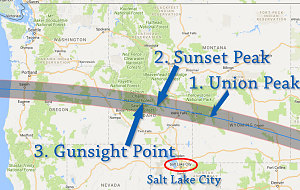
Three potentials
You might ask... what are the best criteria to use for selection of an eclipse viewing spot? Well, the first one is obvious: position yourself directly on the center of the path of totality. That affords one the longest duration of totality at that point along the path - and since totality is the really good part of the show, you want to maximize that. And given that The Great American Solar Eclipse's length of totality was a relatively short 120 to 180 seconds, you didn't want to waste any of those precious seconds [ by being off from the center of the path of totality ].
The second criteria was around the likelihood of good weather. As in, it would be a supreme drag to fly thousands of miles, set up tons of gear, maybe hike to a special place, only to have the eclipse obscured by clouds. A desert or desert-like place would therefore be ideal. And thirdly, something scenic and mountainous - a criteria perhaps more specific to me - would be nice.
Fortunately, the path of totality passed directly through such an area - the upper mountain west of the US: Eastern Oregon, Idaho, Wyoming. All relatively semi-arid, and usually clear and sunny during the summer months. Plus lots of nice mountains.
I spent a few months doing some research, and came up with three potential spots - all mountain peaks with reasonably easy access, all directly on the path of totality. Perfect for us.
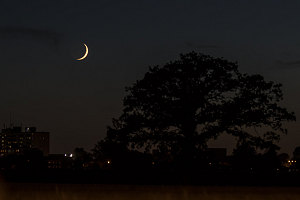
The Last Cycle
The countdown to eclipse week slowly ticked by. I only seriously started doing final preparations when I saw the thin waxing crescent hanging in the night sky in late July... this signalled the beginning of the last lunar cycle before the eclipse, which was going to occur on the morning of August 21. Time to think about how we were going to view and capture this awesome event.
I ordered solar filters and glasses from a reputable online dealer; I spent time in the backyard evaluating my camera gear, trying out both the filters and a set of stacked neutral density filters that I had calculated would absorb the right amount of light. Turned out that the stacked filters offered better image quality (I know about the arguments about unknown amounts of IR and UV absorption with ND filters, but I never looked into the filtered setup for more than a fraction of a second at a time). I bought a 2.0x Teleconverter to bring my total focal length up to 400mm (reasonable for solor disc photography with a bit of cropping), especially with 30 megapixels of resolution.
I carefully recorded all of the settings I used, set up various groups of settings for the partial and total phases of the eclipse, saved them into custom settings on my cameras, and wrote meticulous notes about all of it. I knew it would be very important to have everything as automated as possible during the eclipse. It was no time for fussing around and missing out on actually looking at one of nature's greatest spectacles.
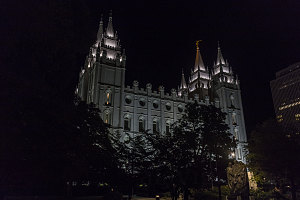
Salt Lake City
We flew down to Salt Lake City - the closest big center to our chosen eclipse viewing locations - on Friday, August 18th - more than two full days before the Monday morning eclipse. I wanted lots of buffer to deal with any logistical hurdles we might encounter, and to ensure that we were prepped and ready and looking skyward on Monday morning.
Saturday - two days before the eclipse, I had another - this time very detailed - look at the forecast for each of the three eclipse viewing locations. I had a preferred location - the top of Union Peak at the northern end of the Wind River Range in Wyoming, but the forecasts were pretty consistently showing it losing out in cloud-cover percentage to a spot in north-central Idaho's White Cloud Mountains. The latter was consistently showing 0% probability of precipitation and less than 3% cloud cover for the entire eclipse day. Ignoring these numbers wasn't a wise idea, so... Idaho it was!
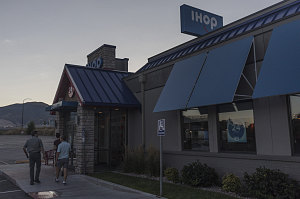
Trip Start Breakfast
Going to our Idaho location meant a longer drive, and we spent most of the day on the interstates of Utah and Idaho, crossing hundreds of miles of arid, rolling countryside. We stopped in the capital of Boise to get food and camping supplies. From there, we headed northeast, into increasingly mountainous terrain.
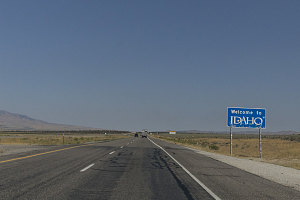
We choose Idaho
The sun shone down unblinkingly during the entire day - an entirely normal warm summer day. There was nothing at all in the natural world around us to indicate that an extremely rare celestial event was about to occur in less than 48 hours. However, there *were* signs of human awareness everywhere, and it was rather curious to see: almost all of the electronic signs on the highways referenced the eclipse: 'no stopping on highways during the eclipse', 'expect congestion during Monday eclipse', etc. In stores, there were eclipse cookies and cupcakes. Restaurant in towns within the path of totality had special eclipse viewing bars set up outside. Designated viewing parking areas with rows of portable toilets were set up in a few locations. The eclipse was big news.
Eclipse info from Forest Service
On we drove, though increasingly beautiful scenery and past increasingly intense eclipse mania. Now, one of the reasons I had chosen this particular viewing spot was because it seemed remote - and it was, but as we approached the backcountry trailhead on a dusty forest road, we saw a hand-scrawled sign that said "trailhead parking full".
In certain circumstances I may have turned around at such a sign, but this weekend was different, and I felt reasonably confident that if push came to shove, I could find some place into which to squeeze our Dodge Journey.
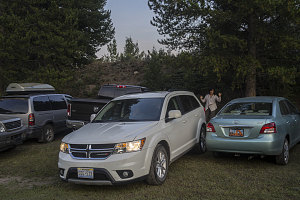
courtesy PChen
Packed Trailhead
The Big Boulder Lakes trailhead of the White Cloud Mountains was indeed very full - overfull, actually, with vehicles parked willy-nilly everywhere, directly in the bush and between boulders in many locations. We carefully poked around and found - happily - a grassy spot between two vehicles that seemed a bit tight but which upon closer inspection was more than capable of accepting our rental car. In we went.

Running Roughshod
We had arrived too late in the evening to head into the backcountry to camp, so we made do with a reasonably flat spot behind a row of cars, carefully avoiding the horse dung that seemed to be strewn everywhere (apparently the trail network around here allowed horses).
So, phase 1 of our eclipse adventure had gone off reasonably well: we were fully stocked and positioned within a day's walk of the best of our three eclipse viewing locations. This was starting to get a little exciting!